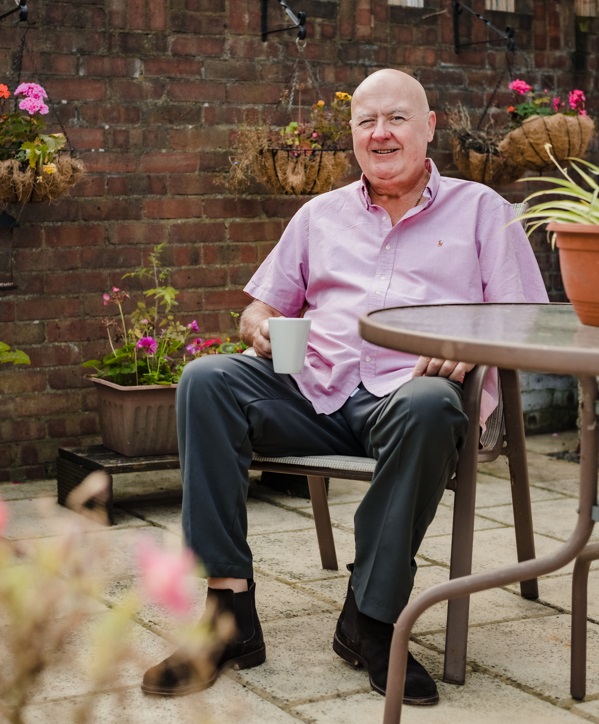Donor appeal after September sees highest COVID convalescent plasma use
NHS Blood and Transplant is repeating its urgent call for COVID-19 convalescent plasma donors as new figures show plasma transfusions reached a high during September.
Over the month, around 220 or more people had received convalescent plasma through the collaborations with the RECOVERY and REMAP-CAP trials. (1)
This is the highest monthly figure since the first plasma transfusions in May. It is also more than four times the number of plasma recipients during August.
John's story
A recent plasma recipient is John Curtis, 58, a taxi driver, and a dad of two, from Romford in Essex.
John said: “I’d gone back to work after lockdown and then developed a dry cough. I put it down to the aircon but it got worse. I went to the drive through and had a positive test.
“The next day I woke up and felt like I had run a marathon up and down the stairs. I phoned 111 and I had to break off from talking to get my breath. They sent an ambulance and I was taken into the Queen’s Hospital in Romford.
“I felt frustrated I hadn’t got things sorted properly for my kids. I felt like I could walk out alive or get carried out.
“On the ward, they said you can go into the trial and there are three different things I could have, one of them plasma. I said I will take part in anything to try and combat this thing. I had to sign a form and they came around with the plasma.
“It was like a bag of orange fluid, about half a litre. I had one unit a day for two days. It went through me in about half an hour.
“I like to think it helped, though the trial is still going on. My son is a doctor with some experience of it and he thinks it helped.
“I am planning to donate next month after I feel better than I do now. I hope to help someone myself.”
An urgent need
Sheila MacLennan, NHSBT transfusion consultant and Clinical Lead for the Convalescent Plasma Programme, said: “These figures show why we urgently need people who’ve had coronavirus to donate now, so plasma will be there in the coming weeks and months.
“Our stocks are good but it will only stay that way if people keep donating. We especially need men to donate as they are more likely to have high enough antibody levels for the trial. (2)
“We think the increase is partly the result of the national rise in coronavirus cases and partly the result of more hospitals taking part in plasma arms of the trials.” (3)
Professor Jonathan Van-Tam, the Deputy Chief Medical Officer, said: “Clinical trials are running across the UK to find safe and effective treatments to treat COVID-19 and, ultimately, save lives.
“The RECOVERY and REMAP-CAP trials in the UK are trialling convalescent plasma to determine whether it works as a treatment for COVID-19.
“I urge people to do two things. One, to consider volunteering for clinical trials. These are the only way to obtain really high quality evidence about what works and what doesn’t. RECOVERY did this with dexamethasone, which is now saving lives globally.
“Two, for those who have had COVID-19, and are eligible, to donate plasma so it can be trialled, and if it is shown to work, to be used as a treatment. We need to build up the amount of plasma we have now, so it can be used in the future. Both of these are concrete actions you can take and possibly save someone else’s life.”
About plasma donation
COVID-19 convalescent plasma is being collected at NHSBT’s 23 donor centres around the country, and five pop-up donor centres. London, Greater Manchester and Birmingham are priority areas for donation. More pop-up plasma donor centres will be opening during the autumn.
Donation takes about 45 minutes. The whole visit – including the donation, snacks and checks - takes about 1 hour 15 minutes. Your body usually replaces the plasma you’ve donated in 24-48 hours. Your body also quickly replaces the donated antibodies. All donations are tested for COVID antibodies.
If you’ve had confirmed coronavirus or the symptoms, you can volunteer to donate plasma today.
Notes
- As of the morning of September 28, 916 people had been randomised into the convalescent plasma arms of the RECOVERY and REMAP-CAP trials. Around half of these people received convalescent plasma.
- A man booked in to donate for the first time is three times more likely to give a high antibody unit of plasma than a woman booked in to donate for the first time. This is partly because men are more seriously affected by COVID and produce more antibodies. It is partly because men are more likely to have large enough blood volumes and veins to meet the donation criteria.
- As of the morning of September 28, 116 hospitals are now collaborating with the plasma arm of REMAP-CAP and 184 hospitals are collaborating with the plasma arm of RECOVERY. The plasma arm of REMAP-CAP is open to adults in intensive care with COVID. The plasma arm of RECOVERY is open to children and adults admitted to hospital with COVID.
